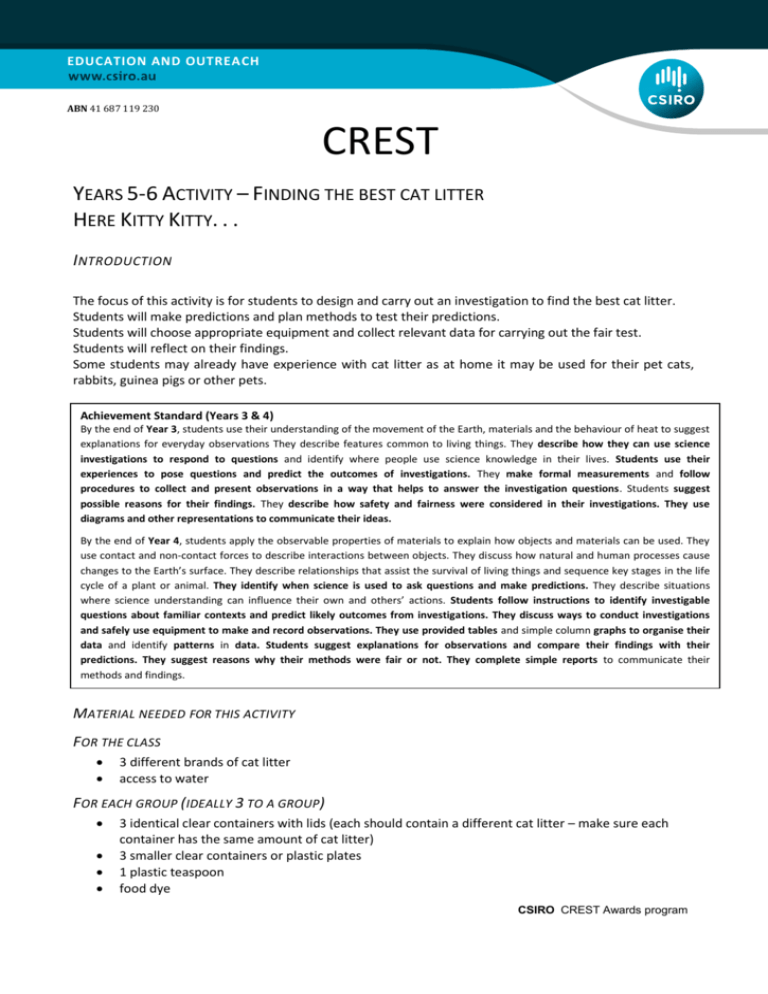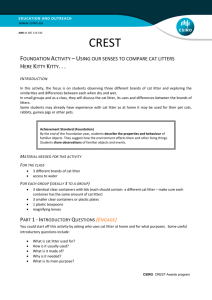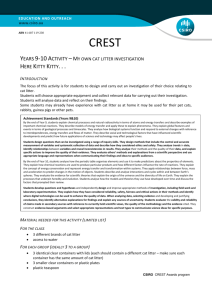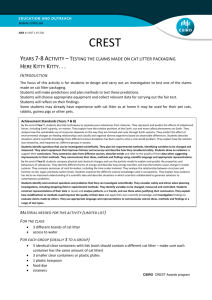Year 5-6 CREST Activity
advertisement

EDUCATION AND OUTREACH EDUCATION AND OUTREACH ABN 41 687 119 230 CREST YEARS 5-6 ACTIVITY – FINDING THE BEST CAT LITTER HERE KITTY KITTY. . . I NTRODUCTION The focus of this activity is for students to design and carry out an investigation to find the best cat litter. Students will make predictions and plan methods to test their predictions. Students will choose appropriate equipment and collect relevant data for carrying out the fair test. Students will reflect on their findings. Some students may already have experience with cat litter as at home it may be used for their pet cats, rabbits, guinea pigs or other pets. Achievement Standard (Years 3 & 4) By the end of Year 3, students use their understanding of the movement of the Earth, materials and the behaviour of heat to suggest explanations for everyday observations They describe features common to living things. They describe how they can use science investigations to respond to questions and identify where people use science knowledge in their lives. Students use their experiences to pose questions and predict the outcomes of investigations. They make formal measurements and follow procedures to collect and present observations in a way that helps to answer the investigation questions. Students suggest possible reasons for their findings. They describe how safety and fairness were considered in their investigations. They use diagrams and other representations to communicate their ideas. By the end of Year 4, students apply the observable properties of materials to explain how objects and materials can be used. They use contact and non-contact forces to describe interactions between objects. They discuss how natural and human processes cause changes to the Earth’s surface. They describe relationships that assist the survival of living things and sequence key stages in the life cycle of a plant or animal. They identify when science is used to ask questions and make predictions. They describe situations where science understanding can influence their own and others’ actions. Students follow instructions to identify investigable questions about familiar contexts and predict likely outcomes from investigations. They discuss ways to conduct investigations and safely use equipment to make and record observations. They use provided tables and simple column graphs to organise their data and identify patterns in data. Students suggest explanations for observations and compare their findings with their predictions. They suggest reasons why their methods were fair or not. They complete simple reports to communicate their methods and findings. MATERIAL NEEDED FOR THIS ACTIVITY FOR THE CLASS 3 different brands of cat litter access to water FOR EACH GROUP (IDEALLY 3 TO A GROUP) 3 identical clear containers with lids (each should contain a different cat litter – make sure each container has the same amount of cat litter) 3 smaller clear containers or plastic plates 1 plastic teaspoon food dye CSIRO CREST Awards program EDUCATION AND OUTREACH EDUCATION AND OUTREACH ABN 41 687 119 230 CREST strainers stopwatch measuring cylinders or medicine cups PART 1 - INTRODUCTORY QUESTIONS (ENGAGE) You could start off this activity by asking who uses cat litter at home and for what purposes. Some useful introductory questions include: What is cat litter used for? How is it usually used? What is it made of? Why is it needed? What is its main purpose? Give each group set of three clear containers that contain the different cat litters. Let them have a closer look at the three different samples. Ask students to draw what each cat litter looks like and to write a description for each. Ask students to discuss in their group what they think a good cat litter should be like. (possible answers may include - quickly absorbs lots of liquid, holds lots of liquid, absorbs smells) Give students access to the packaging of the litter and let them know how much each brand cost. Some brands have different claims and different properties. Discuss these with the students. Discuss the difference in prices between the three cat litters (if any). Ask students which cat litter they think would be the best one to buy. Why? PART 2 –THE ‘BEST’ CAT LITTER (EXPLORE, EXPLAIN) For this sections students can work in small groups (maximum of 3) or individually. (a) Ask the students to think about how they could carry out an investigation to find the best cat litter. Discuss with the students that the definition of “best” can vary. It is up to them to decide what is meant by “best” but they need to be specific about their meaning. (eg absorbs most liquid, absorbs liquid the fastest etc) They could use what they learned in the discussion to guide them in choosing what they mean by ‘best’. (b) Once each group, or student working individually, has decided on their meaning of ‘best’ they will need to design their investigation further. Students should be familiar with the concepts of fair testing and the need to control variables. Use the Focus questions below to help structure their discussions. Focus questions You are comparing the different brands of cat litter so the brand of cat litter is the only thing you should be changing in your experiment. CSIRO CREST Awards program EDUCATION AND OUTREACH EDUCATION AND OUTREACH ABN 41 687 119 230 CREST What will things will you need to keep the same during the investigation? How will you do this? What will you be measuring? How will you actually measure this? What equipment are you going to use? Is it available? What will you record? Are there any safety precautions you need to take? List the steps you will do in your investigation. Have you designed a fair test? Make sure that students understand that they will be only changing one thing (the brand of cat litter) and only measuring one thing (the amount of water not absorbed). (c) Before students begin carrying out their investigations ask them to write in their books their prediction of which cat litter they think will be the ‘best’, based on their definition of ‘best’. (d) They should also write a step by step plan of their investigation. If you are registered for CREST you can use the CREST Science Investigation Planner – Intermediate to assist the students. T EACHER N OTES Cat litters are made from different materials and are vey different in density, texture and appearance. Although many of the cat litter products are made from recycled paper products care should still be exercised. This activity requires students to be specific about their definitions and their methodology. Clarity is an important skill in science so others are able to follow and undertake the same investigation if they wish. Before commencing the activity students should be familiar with the concepts of fair testing and the need to control variables. (e) Students should repeat their experiment three times and average their results. If you are registered for CREST, the CREST Student Handbook – Science contains detailed descriptions of the open investigation process. The Blue CREST Profile Card also provides a checklist of these key steps. CSIRO CREST Awards program EDUCATION AND OUTREACH EDUCATION AND OUTREACH ABN 41 687 119 230 CREST PART 3 – CLASS DISCUSSION (ELABORATE & EVALUATE) a) Discuss with students some of the appropriate ways of presenting their results (graphs, tables). In science the variable that is changed in an experiment (independent variable) is always recorded on the horizontal axis of the graph and the variable that is measured (dependent variable) on the vertical axis. What was measured What was changed If students are familiar with Microsoft Excel they can utilise this to produce a column/bar graph of their average results. b) When students have finished and recorded their results, ask each group to share with the rest of the class what they did and which cat litter they found to be the ‘best’. They will need to say how they defined ‘best’. The class discussion should also focus on ways they could improve on their methods if they were to do the investigation again. What did they find difficult when doing this experiment? What would they change to make it better? A SSESSMENT R UBRIC This assessment rubric links is based on the content descriptors of the Science Inquiry Skills strand of the Australian Curriculum: Science It is provided as guide for you to use with the above activity. Please feel free to adapt or develop your own rubric to use with your students. Science Inquiry Skills Questioning and Predicting Developing Consolidating Does not pose questions to clarify practical problems or inform a scientific investigation, or predict what the findings of the investigation might be. Struggles to pose questions to clarify practical problems or inform a scientific investigation, and predict what the findings of the investigation might be, even with guidance. Achieving With guidance, pose questions to clarify practical problems or inform a scientific investigation, and predict what the findings of the investigation might be. CSIRO CREST Awards program EDUCATION AND OUTREACH EDUCATION AND OUTREACH ABN 41 687 119 230 CREST Planning and Conducting Fails to select appropriate investigation methods for the cat litter experiment. Can not decide which variable should be changed and measured in the fair test and accurately observe, measure and record data, using digital technologies as appropriate. Does not use equipment and materials safely or identify potential risks. Processing and Analysing Data and Information Evaluating Communicating Struggles to construct and use a limited range of representations, including tables and graphs to represent and describe observations, patterns or relationships in data using digital technologies as appropriate. Fails to compare data with predictions and use as evidence in developing explanations. Can not suggest improvements to the methods used in the cat litter experiment. Struggles to communicate ideas, explanations and processes in any way. Struggles to select appropriate investigation methods for the cat litter experiment, even with guidance. Only with guidance manages to decide which variable should be changed and measured in the fair test and accurately observe, measure and record data, using digital technologies as appropriate. Needs assistance to use equipment and materials safely, identifying potential risks. With assistance can construct and use a limited range of representations, including tables and graphs to represent and describe observations, patterns or relationships in data using digital technologies as appropriate. Struggles to compare data with predictions and use as evidence in developing explanations. Only with assistance can suggest improvements to the methods used in the cat litter experiment. Communicates ideas, explanations and processes in a limited number of ways. With guidance, select appropriate investigation methods for the cat litter experiment. Decide which variable should be changed and measured in the fair test and accurately observe, measure and record data, using digital technologies as appropriate. Use equipment and materials safely, identifying potential risks. Construct and use a range of representations, including tables and graphs to represent and describe observations, patterns or relationships in data using digital technologies as appropriate. Compare data with predictions and use as evidence in developing explanations. Suggest improvements to the methods used in the cat litter experiment. Communicate ideas, explanations and processes in a variety of ways, including multimodal texts. This activity also links to the following in the Australian Curriculum: Science CSIRO CREST Awards program EDUCATION AND OUTREACH EDUCATION AND OUTREACH ABN 41 687 119 230 CREST Science as a Human Endeavour Nature and development of science Science involves testing predictions by gathering data and using evidence to develop explanations of events and phenomena. Use and influence of science Scientific understandings, discoveries and inventions are used to solve problems that directly affect peoples’ lives. Scientific knowledge is used to inform personal and community decisions. CREST Link This activity extends the Green and Orange CREST Science Activity Pets and Other Animals topic. A copy of the activity is available in the Introductory CREST Teacher Handbook. By completing this activity, students may be eligible to receive a Blue CREST Award. CREST Science Investigation Planner – Basic. This investigation planner is designed to be used with sticky notes. It helps students identify the variables in their experiment and organise their variables so they can ensure that they are only changing one thing and only measuring one thing. CREST Science Investigation Planner – Intermediate. This investigation planner is an extension of the Basic planner above to further assist students throughout the open investigation process. Downloads of both planners can be found at www.csiro.au/crestonline The CREST Student Handbook – Science containing detailed descriptions of each step in the open investigation process as well as the Blue CREST Profile Card are provided to assist students working at the Blue CREST Award level. More information about CREST is available at www.csiro.au/crest CSIRO CREST Awards program






